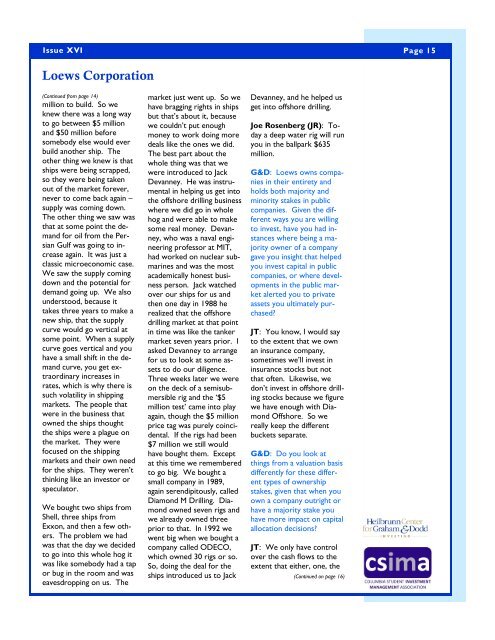Graham & Doddsville - Columbia Business School
Graham & Doddsville - Columbia Business School
Graham & Doddsville - Columbia Business School
Create successful ePaper yourself
Turn your PDF publications into a flip-book with our unique Google optimized e-Paper software.
Issue Volume XVI I, Issue 2 Page 15<br />
Loews Corporation<br />
(Continued from page 14)<br />
million to build. So we<br />
knew there was a long way<br />
to go between $5 million<br />
and $50 million before<br />
somebody else would ever<br />
build another ship. The<br />
other thing we knew is that<br />
ships were being scrapped,<br />
so they were being taken<br />
out of the market forever,<br />
never to come back again –<br />
supply was coming down.<br />
The other thing we saw was<br />
that at some point the demand<br />
for oil from the Persian<br />
Gulf was going to increase<br />
again. It was just a<br />
classic microeconomic case.<br />
We saw the supply coming<br />
down and the potential for<br />
demand going up. We also<br />
understood, because it<br />
takes three years to make a<br />
new ship, that the supply<br />
curve would go vertical at<br />
some point. When a supply<br />
curve goes vertical and you<br />
have a small shift in the demand<br />
curve, you get extraordinary<br />
increases in<br />
rates, which is why there is<br />
such volatility in shipping<br />
markets. The people that<br />
were in the business that<br />
owned the ships thought<br />
the ships were a plague on<br />
the market. They were<br />
focused on the shipping<br />
markets and their own need<br />
for the ships. They weren’t<br />
thinking like an investor or<br />
speculator.<br />
We bought two ships from<br />
Shell, three ships from<br />
Exxon, and then a few others.<br />
The problem we had<br />
was that the day we decided<br />
to go into this whole hog it<br />
was like somebody had a tap<br />
or bug in the room and was<br />
eavesdropping on us. The<br />
market just went up. So we<br />
have bragging rights in ships<br />
but that’s about it, because<br />
we couldn’t put enough<br />
money to work doing more<br />
deals like the ones we did.<br />
The best part about the<br />
whole thing was that we<br />
were introduced to Jack<br />
Devanney. He was instrumental<br />
in helping us get into<br />
the offshore drilling business<br />
where we did go in whole<br />
hog and were able to make<br />
some real money. Devanney,<br />
who was a naval engineering<br />
professor at MIT,<br />
had worked on nuclear submarines<br />
and was the most<br />
academically honest business<br />
person. Jack watched<br />
over our ships for us and<br />
then one day in 1988 he<br />
realized that the offshore<br />
drilling market at that point<br />
in time was like the tanker<br />
market seven years prior. I<br />
asked Devanney to arrange<br />
for us to look at some assets<br />
to do our diligence.<br />
Three weeks later we were<br />
on the deck of a semisubmersible<br />
rig and the ‘$5<br />
million test’ came into play<br />
again, though the $5 million<br />
price tag was purely coincidental.<br />
If the rigs had been<br />
$7 million we still would<br />
have bought them. Except<br />
at this time we remembered<br />
to go big. We bought a<br />
small company in 1989,<br />
again serendipitously, called<br />
Diamond M Drilling. Diamond<br />
owned seven rigs and<br />
we already owned three<br />
prior to that. In 1992 we<br />
went big when we bought a<br />
company called ODECO,<br />
which owned 30 rigs or so.<br />
So, doing the deal for the<br />
ships introduced us to Jack<br />
Devanney, and he helped us<br />
get into offshore drilling.<br />
Joe Rosenberg (JR): Today<br />
a deep water rig will run<br />
you in the ballpark $635<br />
million.<br />
G&D: Loews owns companies<br />
in their entirety and<br />
holds both majority and<br />
minority stakes in public<br />
companies. Given the different<br />
ways you are willing<br />
to invest, have you had instances<br />
where being a majority<br />
owner of a company<br />
gave you insight that helped<br />
you invest capital in public<br />
companies, or where developments<br />
in the public market<br />
alerted you to private<br />
assets you ultimately purchased?<br />
JT: You know, I would say<br />
to the extent that we own<br />
an insurance company,<br />
sometimes we’ll invest in<br />
insurance stocks but not<br />
that often. Likewise, we<br />
don’t invest in offshore drilling<br />
stocks because we figure<br />
we have enough with Diamond<br />
Offshore. So we<br />
really keep the different<br />
buckets separate.<br />
G&D: Do you look at<br />
things from a valuation basis<br />
differently for these different<br />
types of ownership<br />
stakes, given that when you<br />
own a company outright or<br />
have a majority stake you<br />
have more impact on capital<br />
allocation decisions?<br />
JT: We only have control<br />
over the cash flows to the<br />
extent that either, one, the<br />
(Continued on page 16)



